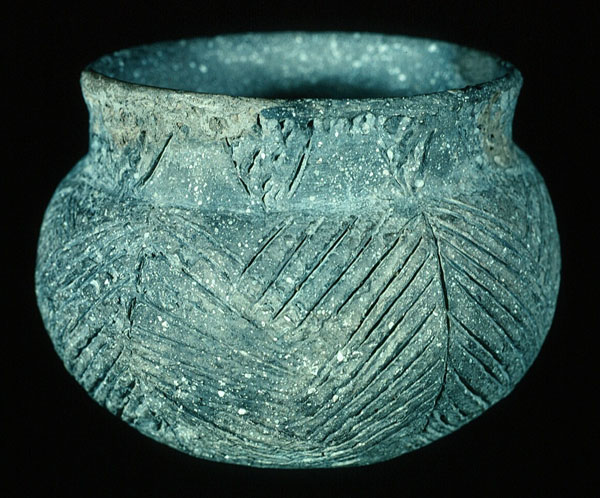

A major innovation occurred in Virginia about 1200 B.C., the production of fired clay cooking and storage vessels. Archaeologists believe this technology was introduced to Virginia from the people along the coast of South Carolina and Georgia. There, the earliest pottery in North America was made beginning about 2500 B.C.
See: Listing of Native American Ceramics
The people manufactured their earthenware vessels from clay dug from along a riverbank. They carefully prepared the clay by adding water and temper (crushed rock or shell) to reduce shrinking and cracking during drying and firing. They did not use a pottery wheel; all pieces were hand built. People built up the sides of a vessel higher, faster, and more uniformly by adding coils of clay, one on top of the other. The coils were pinched together, and the interior of the vessel shaped by scraping. The exterior of the vessel was shaped with a paddle wrapped with cord, fabric, or net. The patterns left by the paddling provide archaeologists with rare examples of textiles that seldom survive hundreds of years of burial in the earth. The vessel was sometimes decorated with incisions and punctuations. Appendages, such as lugs and strap handles, were occasionally added to the vessel. The people didn't paint or glaze their vessels. Finally, the vessel was thoroughly air-dried and place in an open fire to bake.
The Prehistoric Ceramic Listing has been created to present wares, defined by archaeologists, in a simple format to both researchers and the general public. Indian ceramics in Virginia represent a three-dimensional puzzle of continuous style development through space and more than 3,000 years of time. Pottery production was a 'cottage industry,' conducted by families with the knowledge of manufacture handed down from mother to daughter. Archaeologists define wares that reflect these variables of methods of manufacture, space and time. Analytical units of this kind are referred to as historical wares. A ware is a grouping of pottery types of similar method of manufacture, paste, temper and vessel form that occur in a particular locality at a particular period of time. A type is a class of ceramics of one ware that share the same surface treatment. This wealth of pottery information provides archaeologists with ways to help date sites and to define Indian groups and interpret their interaction and movement.
See also:
See Also Herbert Poster SAA 2007
This is just the beginning of an ongoing attempt to organize the published prehistoric wares of Virginia. Please send your comments to Keith Egloff, Virginia Department of Historic Resources, Richmond.